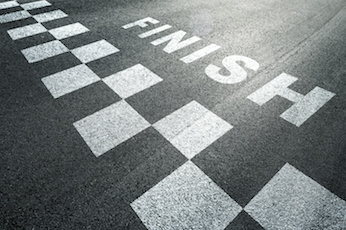I’d like to share an invaluable technique that improves both your productivity and your motivation: Deliberately plan to reach a finishing point in your work every half hour.
A finishing point is different from a stopping point. For example, if you’re juggling, and you just stop, the balls will fall to the ground. But if you finish juggling, you catch the balls in your hands. You can then either start a new juggling routine, or put the balls away, whichever is appropriate.
You may be concerned that you can’t finish in a half hour. That may very well be true. But you can carve off and finish some aspect of the task, so that it’s done, and you have a smaller task ahead of you.
If you leave work as a big blob, with the instruction, “just do all that stuff,” it is easy to get diverted by some aspect of the blob. Before you know it, you’ll use up all your time on something that is not that important.
For example, I need to be careful about this when I clear email. If I treat it as a blob, I answer the emails in front of me, but I can easily bog down in a long response. In my first half hour doing email, it’s better to ensure that I read every email in the inbox, so that I have an overview and I can make an intelligent decision about how and when to respond to the other emails. So during that first half hour, I may start by making quick responses, but I’ll keep an eye on the time, and increase my threshold for responding if I haven’t read them all.
When you have a clear finishing point you are aiming at, this half hour, you have a purposeful attitude. You can recognize diversions for what they are. You see that you can’t go down the garden path and still achieve the goals in that time.
I am often surprised that a project is more complicated than I had vaguely envisioned. Knowing the ultimate outcome is not enough to guide the steps. By figuring out the finishing point(s), I put critical thought into how best I can get there.
Most plans start at the beginning and work forward, or start at the end and work backward. There is nothing wrong with either of these processes, but on a complex task it’s hard to get a complete picture that connects the beginning and the end. Identifying finishing points every half hour helps you figure out those points in the middle, and link the whole project.
When I first started using the finishing points technique, I used it only when I was concerned that I might not get back to a project immediately. I knew it was a lot easier to start juggling again when the balls had been neatly put away, than when I had to search all over the room for where they had scattered on the floor.
But I’ve learned that this method is valuable, whenever I have a task that will take more than an hour.
Adding in frequent finishing points to your work takes a small investment of time and effort to identify them. But it helps you to be more productive, because you focus on a specific result, and therefore make the push to finish. Because you know your goal, you don’t get distracted so easily. And perhaps most of all, you stay motivated, because you see results.
There is nothing more motivating than success. Adding frequent finishing points into your work will help you see results, throughout a given day. That is exciting, life-affirming, and motivating for you.









Great idea Jean! I am fixing to switch my music method books over to print-on-demand (Amazon). Right now, I have to print and bind them. To print and bind 60 books and prepare them for shipment to Amazon, takes about 2 days.
So, I make sure to take breaks or ending points. Print 15 books . . . break, print 15 books, another break. Bind 15 break, etc. Otherwise it becomes overwhelming, or it seems that way.
Since the printing and binding is not a part of the creative process, it is somewhat of a chore. On breaks I relax or turn my mind to creative projects.
GM
Thanks for sharing, Glenn!